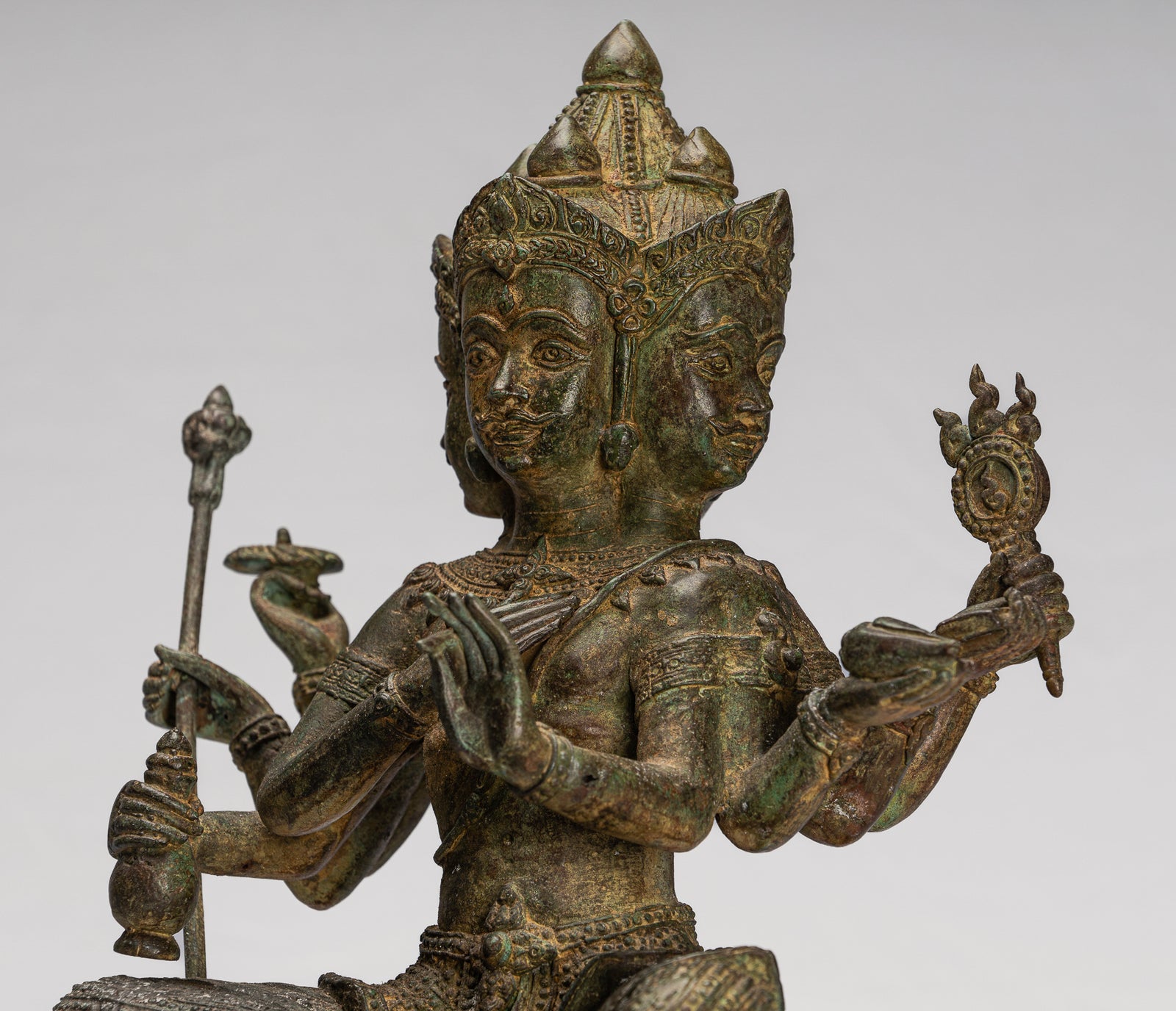
The Rise of Brahma in Thailand: From Hindu Roots to Buddhist Integration
Brahma, the Hindu god of creation, has a significant but often understated role in the cultural and religious practices of Thailand.
While Brahma's prominence in the country is less than that of other deities such as Buddha or Phra Phrom, his influence remains strong through artistic depictions, shrines, and ceremonies. T
he rise of Brahma in Thailand is tied to the complex interplay between Hindu and Buddhist traditions, which has shaped the country's religious landscape over centuries.
This blog post explores the historical, cultural, and religious development of Brahma in Thailand, tracing his roots from Hinduism into Buddhist practice and understanding his place in Thai society today.
Brahma's Origins in Hinduism
Brahma is one of the three principal gods in Hinduism, part of the Trimurti along with Vishnu, the preserver, and Shiva, the destroyer. As the god of creation, Brahma is responsible for the creation of the universe and all living beings within it. His traditional iconography includes four faces, each representing one of the Vedas, and four arms, holding sacred objects like a lotus and a book.
Brahma's role in Hinduism is immense, but in practice, he is often considered less worshipped than Vishnu or Shiva, which could explain why his presence is more subtle in Thailand compared to other Hindu deities.
Brahma’s Journey to Thailand: Hindu Influence in Southeast Asia
Hinduism first spread to Southeast Asia, including Thailand, through trade, migration, and cultural exchange, particularly during the Khom Empire (9th-13th centuries) and the Sukhothai Kingdom (1238–1438). During these periods, Hinduism deeply influenced the architecture, religious rituals, and cultural practices of the region. Indian traders, scholars, and royalty brought with them not only the Hindu pantheon but also a rich cultural heritage that would later blend with the local beliefs and practices.
In Thailand, the influence of Hinduism is visible in the many Hindu deities represented in art and culture, and Brahma, as a central figure of the Trimurti, was integrated into these early practices.
Brahma's Integration with Thai Buddhism
While Thailand is predominantly a Buddhist country today, it was influenced by Hinduism in the early stages of its civilization. When Theravada Buddhism became the dominant religion in the kingdom, it adapted and absorbed many elements from Hinduism. Brahma, as one of the prominent Hindu gods, was seamlessly incorporated into Thai Buddhist religious life, albeit in a modified form.
1. Brahma as Phra Phrom
In Thailand, Brahma is often referred to as Phra Phrom (พระพรหม). While Phra Phrom is a representation of the Hindu god Brahma, his depiction in Thailand and other Southeast Asian countries such as Cambodia and Laos has been adapted to fit within the Buddhist context. Phra Phrom is viewed not only as a god of creation but also as a symbol of prosperity, fortune, and protection.
Phra Phrom is widely revered in Thailand, especially in Bangkok, where the Erawan Shrine (located at the Erawan Hotel) is dedicated to him. The shrine, built in 1956, houses a statue of Phra Phrom, and devotees from all walks of life come to offer prayers, incense, flowers, and even gold leaf, seeking blessings for good fortune and success.
2. Brahma and the Buddhist Cosmology
In Buddhist cosmology, Brahma is not seen as the supreme deity in the same way he is in Hinduism. Instead, he is considered a god of a higher realm—a deva—who resides in the Brahmaloka, a celestial plane. While Buddhism does not worship gods in the way Hinduism does, deities like Brahma are acknowledged as powerful beings who can assist in spiritual progress but are ultimately subject to the impermanent nature of the world.
Brahma’s role in Thai Buddhism is therefore more symbolic and functional. He is recognized as a benevolent figure who provides blessings, protection, and good fortune, but he is not a central focus of worship or devotion. His presence in Thai culture is as much a reflection of the ancient cultural traditions that shaped the country as it is a testament to the syncretic nature of Thai religious practices.
Brahma in Thai Art and Architecture
Brahma’s influence is also evident in Thai art and architecture, where depictions of him are common. He is often seen in traditional Thai paintings, sculptures, and murals, where his four faces symbolize the vastness of the divine creation and his wisdom. These artistic depictions are especially prominent in the Grand Palace and other royal temples, where the fusion of Hindu and Buddhist motifs is visible.
1. The Erawan Shrine
The Erawan Shrine in Bangkok is the most famous site for the worship of Phra Phrom in Thailand. The shrine was originally built to appease the spirits that were believed to have caused construction problems for a nearby hotel. Devotees of all backgrounds—Thai and foreign—come here to pray for success in business, health, and family life. The statue of Phra Phrom at the shrine is usually depicted with his four faces, offering a tranquil and divine presence. The Erawan Shrine is also famous for its association with traditional Thai dance performances that are offered as acts of devotion to Phra Phrom.
2. Temple Murals and Sculptures
Brahma’s presence is found in numerous temples and palaces around the country, often in the form of murals or sculptures that illustrate Hindu legends and deities. In temples where Buddhist and Hindu motifs intertwine, Brahma is typically shown in his four-headed form, surrounded by other gods and divine beings, reflecting the integration of Hindu elements into Buddhist religious spaces.
Brahma's Role in Contemporary Thailand
Today, Brahma, in the form of Phra Phrom, continues to be a popular figure in Thai religious practices, especially in relation to wealth, success, and divine protection. In urban areas like Bangkok, you’ll find smaller shrines dedicated to Phra Phrom, where individuals offer incense, flowers, and joss sticks to seek his blessings for their personal and professional endeavors.
While Brahma’s presence is less dominant in comparison to other Buddhist figures such as the Buddha or Phra Than, he remains a part of the religious and cultural fabric of Thailand. His continued worship in Thai society reflects a broader tradition of cultural syncretism, where Hindu deities were absorbed into the Buddhist context, becoming part of a complex, multilayered religious system.
Conclusion: The Enduring Legacy of Brahma in Thailand
The rise of Brahma in Thailand is a testament to the blending of Hindu and Buddhist traditions that have shaped Thai culture over centuries. While Brahma is not a central figure in Thai Buddhism, his presence as Phra Phrom signifies the deep-rooted connections between the two religions and the enduring legacy of Hinduism in Southeast Asia.
From the Erawan Shrine in Bangkok to temple murals and local shrines, Brahma's influence is visible in many aspects of Thai life, symbolizing creation, prosperity, and spiritual growth. His integration into Thai religious practices shows how deities like Brahma can transcend religious boundaries, continuing to inspire devotion, respect, and reverence across cultures and centuries.


